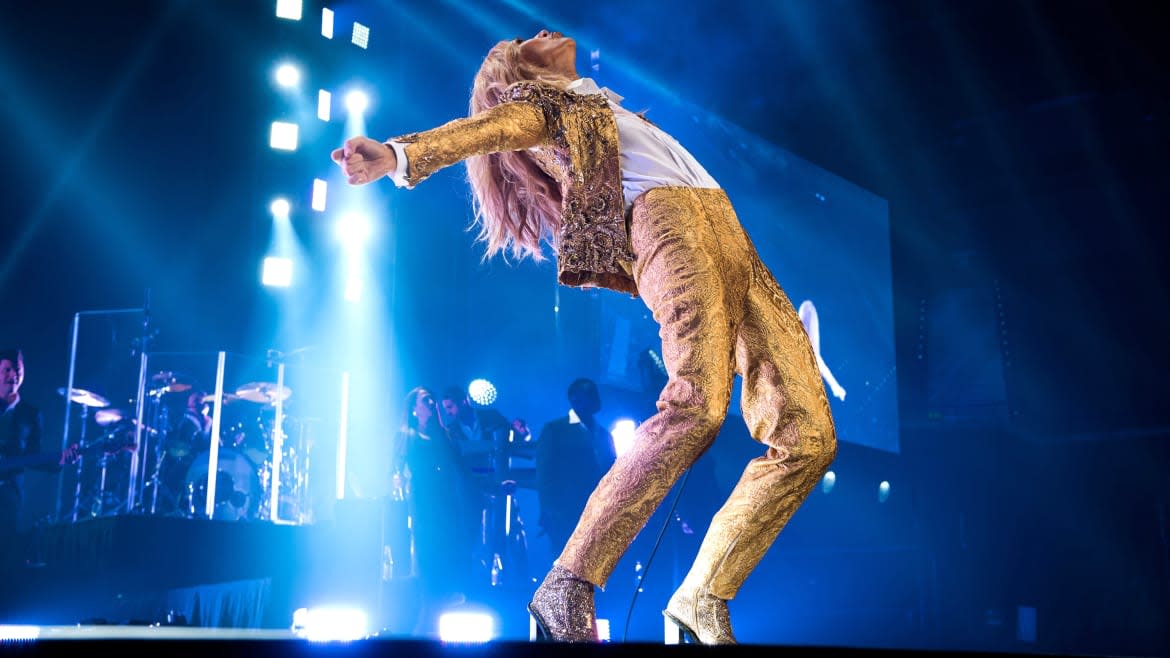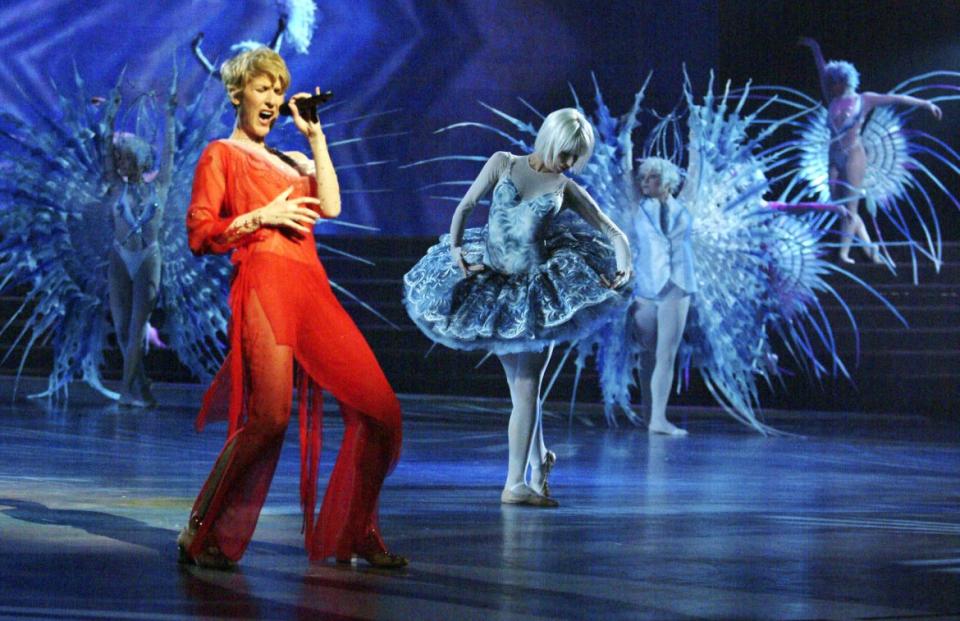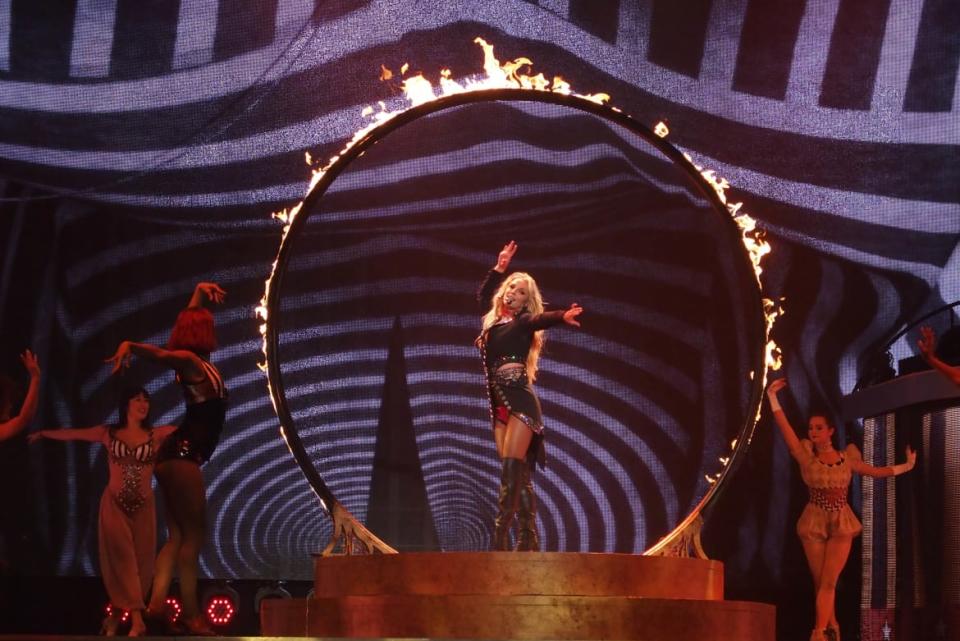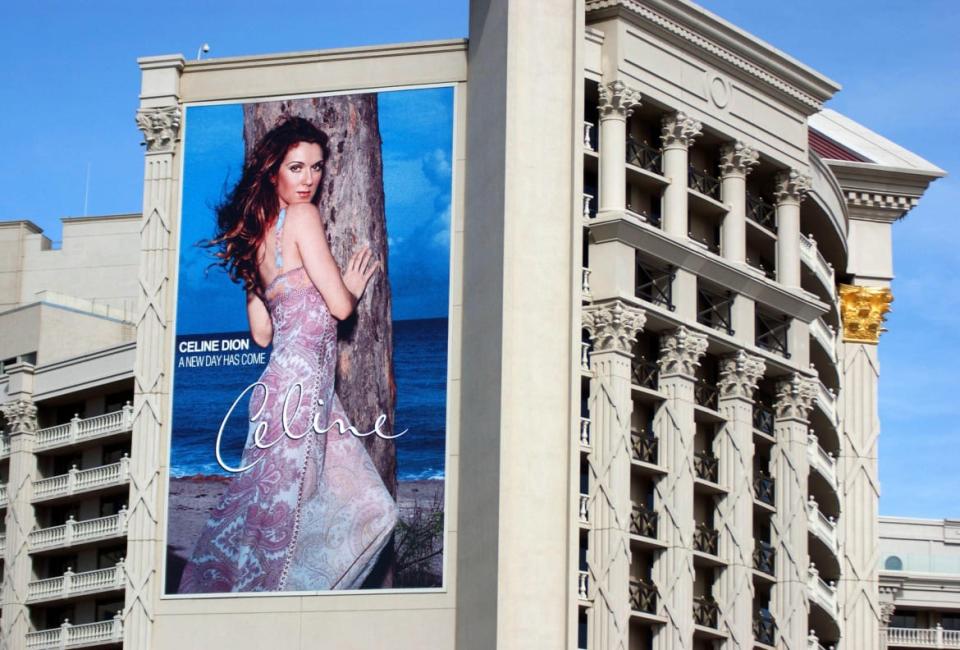How Celine Dion Changed Las Vegas—and Then the Music Industry as We Know It

Celine Dion is ascending.
She is, as she should be, on a pedestal. A column of water rains down around her. She is shimmering, the crystals on her beaded silver gown lighting up, as if electrified by key changes. A knowing look is shared with the audience, 4,298 people with pulses approaching a critical level of danger as they hold their breath in anticipation. Celine Dion is about to belt the bridge to “My Heart Will Go On.”
“You’re heeere…” she sings, effortlessly, angelically, perfectly, undulating through perhaps hundreds of vowel sounds in her Celine Dion vibrato. She whips her beaded cape dramatically, the only way she knows how, creating fabulous wings as the platform raises her toward the rafters of The Colosseum at Caesar’s Palace, “the house that Celine built,” the iconic arena that was erected for her Las Vegas residency debut in 2003.
She has done this, or a version of this, more than 1,000 times in front of more than 4 million people. By my count that is roughly a billion little goosebumps, 500 million tiny hairs on the backs of necks made to stand, and too many raucous rounds of applause to even quantify.
It is roughly 85 minutes before that Dion’s silhouette first appears on the Colosseum stage. Wearing a Schiaparelli couture suit—a pant-and-jacket combo in a gold-foil fabric embellished with a brocade print, in a not-so-subtle homage to Elvis Presley—she struts downstage.
She hits her mark, a command position rooted by her glittering gold boots, and performs a flawless rendition of “Power of Love.” After her first standing ovation of the night, she hams it up with the crowd, an off-the-cuff loopiness that would become a trademark of her show. “We only do it one way, and it’s that way,” she says, both nonsensical and profound. “On Tuesday night! Alright.” Later, she jokes, “I was only supposed to be here for a few months, and here we are 16 years later. What happened?!”
It is a Tuesday in March and, as it happens, the start of a countdown. It is the twentieth-to-last performance of her blockbuster Las Vegas residency.

Celine Dion and dancers rehearse for the upcoming Celine Dion - A New Day concert at The Colosseum at Caesars Palace in Las Vegas, Nevada. Opening night is on March 25, 2003.
Her first residency, A New Day, launched March 25, 2003. Celine premiered in 2011. Its final performance will be this Saturday, June 8.
Hearts may go on (and on…), but residencies, even historic, seminal, seismic, game-changing ones, must come to an end.
If you follow Dion on Instagram, and let us be quite firm about this, you absolutely should be, then you’ve noticed a constant parade of celebrities attending the final performances of Celine, as if a red carpet was leading directly from Hollywood to the Colosseum. Kanye and Kim Kardashian West went to celebrate their fifth anniversary. James Corden featured Dion in his popular “Carpool Karaoke” series. She is on the cover of major fashion magazines.
The pomp and circumstance is fitting; Dion’s residency run has been a triumph. But lost is the distillation of the very real ways that her residency changed, well, everything, from Las Vegas to the music industry to fandom as we know it.
It’s almost too cute, given the town we’re talking about, to call Celine Dion’s decision to start a Las Vegas residency a gamble. But that’s precisely what it was: a singer who, in 2003, was among the most popular and successful pop stars in the world, putting a halt to her lucrative touring schedule to camp out at the Colosseum. It was the equivalent of pitching a tent in an entertainment graveyard.
“Vegas was a place where singers go to die,” Jon Gray, general manager of Palms Casino Resort, says. “Celine changed that.”
Like any truly devout diva worshipper, we took a pilgrimage to our Mecca, the Las Vegas strip, to pay our final respects, going in and out of casinos where, now, the likes of Lady Gaga, Christina Aguilera, Cardi B, and Drake are plastered on billboards once reserved for the Osmonds, Wayne Newton, and Liberace. We talked to managers, venue bookers, and music-industry insiders about the impact Dion has had not only on the city and the culture of Vegas, but on the music business itself and what it means to be an artist in 2019.
As Chas Smith, vice president of entertainment at Hard Rock Hotel, summarizes it, repeating what has become for us a daily mantra, “Thank god for Celine Dion.”
Celine Dion’s first Vegas contract made headlines: five nights a week at Caesar’s Palace, for three years. “It’s unprecedented for a pop superstar to agree to be anchored to one venue for such a length time,” the Los Angeles Times wrote in 2001. It was reported that the deal was worth $45 million, approximating what she would earn on a 40-date world tour at that time in her career.
Prior to Dion, Vegas’ biggest artist announcement happened two years prior, with the news that Wayne Newton had signed a 10-year contract at the Stardust Hotel and Casino. Newton hadn’t released a new album in 20 years. By comparison, Dion had just released A New Day Has Come, which debuted at number one in 17 countries and was eventually certified six times platinum. She had sold more than 37 million albums in the United States alone, and was one of the biggest-selling female artists in recording history.
There was certainly respect in the payday, not to mention the fact that a $124 million venue was being built just for her shows. But it was still…Vegas.
“I remember they ridiculed her for it,” Smith says. “Her reputation suffered. They were like, ‘Oh, she’s done. She’s just going to ride out her career.’”
Her contemporaries on the Strip were, well, not her contemporaries: Newton, Charo, Tom Jones, Donny & Marie. “You lost all your credibility if you were over there playing in lounges or showrooms,” Gary Bongiovanni, then-editor-in-chief of Pollstar, said at the time. In the ’50s and ’60s, Vegas doubled as a clubhouse for Frank Sinatra and the Rat Pack, and the ’70s saw the likes of Elvis take to the desert. But the town increasingly became a place where, if current, popular artists booked stays, it amounted to selling out or semiretirement.
“But Celine paved the way for artists with relevant hits and exciting things coming down the pipeline to think of starting a Vegas residency,” Gray says.
Vegas became a new opportunity, where it was once a last resort. “There was a period of time when the narrative in Vegas was, you came here on your way up or on your way down,” Sean Christie, nightlife executive for MGM Resorts, says. “Celine Dion coming to town was one of those moments where you saw greatness at its peak regularly.”
Timing, of course, is everything. When Dion signed her first deal, she had just given birth months before. Staying in one spot instead of circling the globe on a tour was appealing.
“I can actually lead a pretty normal life in Las Vegas,” she told The Mail on Sunday in 2003. “Yes, I will be a performer, but I’ll also be a wife and mother…During the day I will be with my family, then I will perform and then go home to my bed and my husband. I will cook and clean and make cookies for my boy. It’s perfect.”
Celine Dion: Las Vegas’s New Economic Comeback Strategy
Britney Spears’s Vegas Show Is a Big Fat Hit, Obviously
That’s been a draw for several other artists who followed Dion to the strip, including Britney Spears, for whom stability was paramount when she began her Piece of Me residency in 2013, and Lady Gaga.
“I think one of the reasons we were able to get it done is because we were able to say, this is a blank canvas for you to do whatever you want,” Chris Baldizan, the senior vice president of entertainment booking and development at MGM Resorts, says of landing Lady Gaga to open the theater at the Park MGM. “As opposed to being on tour and the scale of putting your crew and 30 trucks on the road every night, not to mention the wear and tear and the travel.”
But Dion also launched her residency at a time when things were borderline apocalyptic for the music industry. Record sales were flat, and on the verge of plummeting. Artists were being squeezed out of royalties. Live concerts were quickly superseding album sales as the primary generator of an entertainer’s income.
A New Day was a hit, selling out more than 700 consecutive performances at The Colosseum and bringing in more than $400 million, which according to Newsweek was more than the Rat Pack, Liberace and Elvis combined. But that doesn’t mean that major stars immediately followed suit and headed to Vegas. Legacy acts like Cher, Rod Stewart, and Elton John booked lucrative stays, but it wasn’t the same as the biggest star in music setting up a residency in the prime of her popularity.
In fact, the Vegas economy collapsed so drastically during her three-year absence from the city, that when she returned in 2011, that same Newsweek article wondered, “Can Celine Dion Save Las Vegas?”
Maybe she didn’t do it single-handedly, but her return with Celine certainly helped. Not all heroes wear capes. Some wear ice blue Armani gowns.
There is a video, arguably one of the greatest on the internet, that went viral in 2017 of Celine Dion at the Omnia nightclub, the biggest in Las Vegas. The sprawling, multi-level Caesar’s venue typically houses hundreds of young EDM and club-music enthusiasts pumping fists and popping bottles under a 22,000-pound undulating chandelier that moves to the music. Not…Celine Dion.
The story is almost too good. Dion simply walked over to Omnia, crossing the casino floor after one of her performances at The Colosseum. The DJ Steve Aoki was performing that night, and, it turns out, so was Dion. As Aoki played a remix of “My Heart Will Go On,” she climbed the DJ booth and sang along.
The surprise collaboration was to raise money for the Las Vegas Victims’ Fund, but it also epitomized the two factors, as unlikely a pair as Dion and Aoki may be, that most contributed to the Vegas live music scene as we know it today.
As the local economy rebounded in the years after Dion returned to Vegas, the average age of visitors to the city was also rapidly dropping, from 50 to 45, with a notable rise in visitors age 30 to 49. (The fastest growing age segment in Vegas right now is millennials.) Dion’s return in 2011 happened to coincide with the EDM explosion, and, in that aftermath, the DJ boom at Vegas nightclubs.
Paul Oakenfold kicked off the trend with the first DJ residency at the Palms in 2008. Then came Tiesto and Swedish House Mafia. DJ residencies began to define Vegas nightlife, and still very much does. Calvin Harris made headlines when it was reported that he was being paid more than $1 million per show for his residency at Omnia. The Palms recently opened a combination indoor-outdoor dayclub and nightclub called Kaos, booking Marshmello as its marquee residency for what’s reported as the most expensive residency deal yet.
For the DJs, the payday and booking is a certain anointing of stature. For music lovers, it’s meant a rise in destination fandom.
“You have to come to Vegas to see him, and it just shows that he’s a force to be reckoned with,” Sal Wise, vice president of marketing at Hakkasan, says about Harris, noting that, unlike with the pop stars, DJ residencies aren’t a matter of convenience. “You have to say, no matter what I’m doing in the world, I need to be in Vegas every Friday and Saturday, and that requires a real dedication. These guys fly from Spain to Vegas to play, then get on a plane to go back.”
The DJ boom led to that aforementioned rise of younger tourists in Vegas, something that frequent visitor Larry Rudolph, who happened to be Britney Spears’s longtime manager, took notice of. Seizing on what he viewed as a gap in entertainment options outside of the nightclub for those younger visitors, he eyed a residency for the superstar, launching the uber-successful Piece of Me residency in 2013.

Britney Spears in Britney: Piece of Me at The AXIS auditorium in the Planet Hollywood Resort & Casino, Las Vegas, on June 22, 2016.
Nostalgia acts catering to people who grew up in the nineties became the new Vegas trend. Mariah Carey launched her first residency in 2015. Jennifer Lopez followed suit in 2016. Then the floodgates opened: Backstreet Boys, Blink 182, Ricky Martin, Gwen Stefani, Aerosmith.
They were financially lucrative for the entertainers, of course, but also had the power to redirect the narrative of their careers. A Vegas residency meant the expectation that you produce a certain caliber of live performance. Rave reviews for Lopez’s residency changed how critics viewed her as a live act, for example. These residencies also brought with them prestige. Before, these acts would travel to the fans. Now the fans are traveling to them.
“Celine opened people’s eyes that it’s not the end of your career,” says Smith. “This might be the rebirth of your career because now people will travel to see you.”
For fans, the Vegas shows means the opportunity to see their favorite acts in smaller venues. The furthest seat at a Vegas residency may be closer than a premium seat at an arena concert. A $300 ticket to see Lopez’s current tour at Madison Square Garden in July would see you on the opposite end of the stadium from the stage. At her residency at Planet Hollywood, it would have gotten you a VIP table in the front.
It fosters a certain intimacy. Whereas No Doubt fans might remember seeing Gwen Stefani scaling scaffolding at massive arena tour stops, now the singer is inviting them on stage for selfies during set breaks at her Vegas residency at Planet Hollywood. “I think that people’s proximity to greatness is, in part, what this town is about,” says Christie.
It’s not hard to read a certain symbolism into the photo of Celine Dion with her arms wrapped around Lady Gaga, taken soon after Dion was spotted dancing like an angel on ecstasy in the audience of Gaga’s current Vegas residency, Enigma, at the Park MGM.
It heralded a proverbial passing of the torch. Dion, who had bridged one era of Vegas entertainment to another, changing the industry in the process, and Gaga, who represented the future.
The truth is that, much like Dion did back in 2001 when she announced her first residency, Gaga heading to Vegas at the prime of her career—she was nominated for an Oscar as she made her Park MGM debut—marked a seismic shift.

A Celine Dion concert poster hangs on the side of Caesars Palace in Las Vegas, Nevada, on February 7, 2003.
Bruno Mars was announced to join Gaga at the Park MGM. Then, as the months wore on, it seemed like major artists were announcing Vegas residencies every other week. Christina Aguilera at Planet Hollywood. Cardi B at Kaos. Drake at Wynn’s XS Nightclub. Janet Jackson at the Park MGM. Lady Antebellum at the Palms.
Suddenly, music fans who would never have thought of traveling to Vegas are booking tickets for the chance to see top acts. “It’s become an event,” says Baldizan. “It’s changing pop culture.”
The sheer diversity of residencies has become as impressive as it is bizarre. Nostalgia acts like Aerosmith and Billy Idol joining veteran legacy acts like Diana Ross and James Taylor with these major pop stars like Gaga, Mars, and Cardi B all arriving, too. The Las Vegas Strip has started to resemble people’s eclectic music tastes, which tourists have begun to embrace.
“You can go into The Pearl and watch a country or rock or pop act and then go after into the club and see electronic or Latin or hip-hop,” says Gray. “It’s like the way I listen to my Spotify: all over the map.”
The surge in Vegas residencies has fostered a healthy competition among Vegas casinos. “It’s 100 percent an arms race,” says Smith, adding that it’s making labels and artists’ representatives rethink how to plan their acts’ careers. “Artists right now can name their price, basically, at this point.”
Baldizan laughs when asked about the impact of so many new pop acts storming the Strip on the artists already there: “We are in Las Vegas really, really good at copying each other.”
After Celine Dion vacates The Colosseum Saturday, the stage will be occupied by a rotating schedule of performers: Sting, Trevor Noah, Jerry Seinfeld, James Taylor, Luis Miguel, Rod Stewart. More stars will book more residencies. There are major pop stars being teased as possible new residencies, though no one would confirm any of the rumors or negotiations.
Dion herself will embark on a world tour, the exact thing she started in Vegas to avoid. The house that she built will have new tenants, but the industry that she singlehandedly bulldozed and reconstructed? She’ll forever have ownership of that.
Got a tip? Send it to The Daily Beast here
Get our top stories in your inbox every day. Sign up now!
Daily Beast Membership: Beast Inside goes deeper on the stories that matter to you. Learn more.

